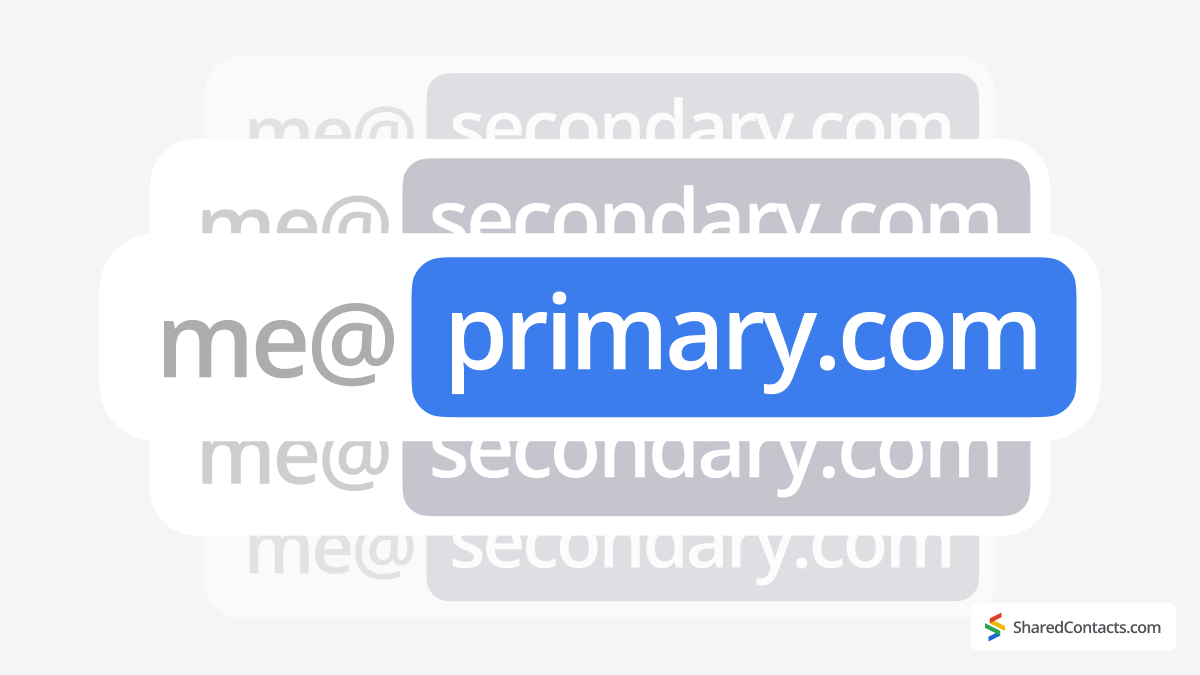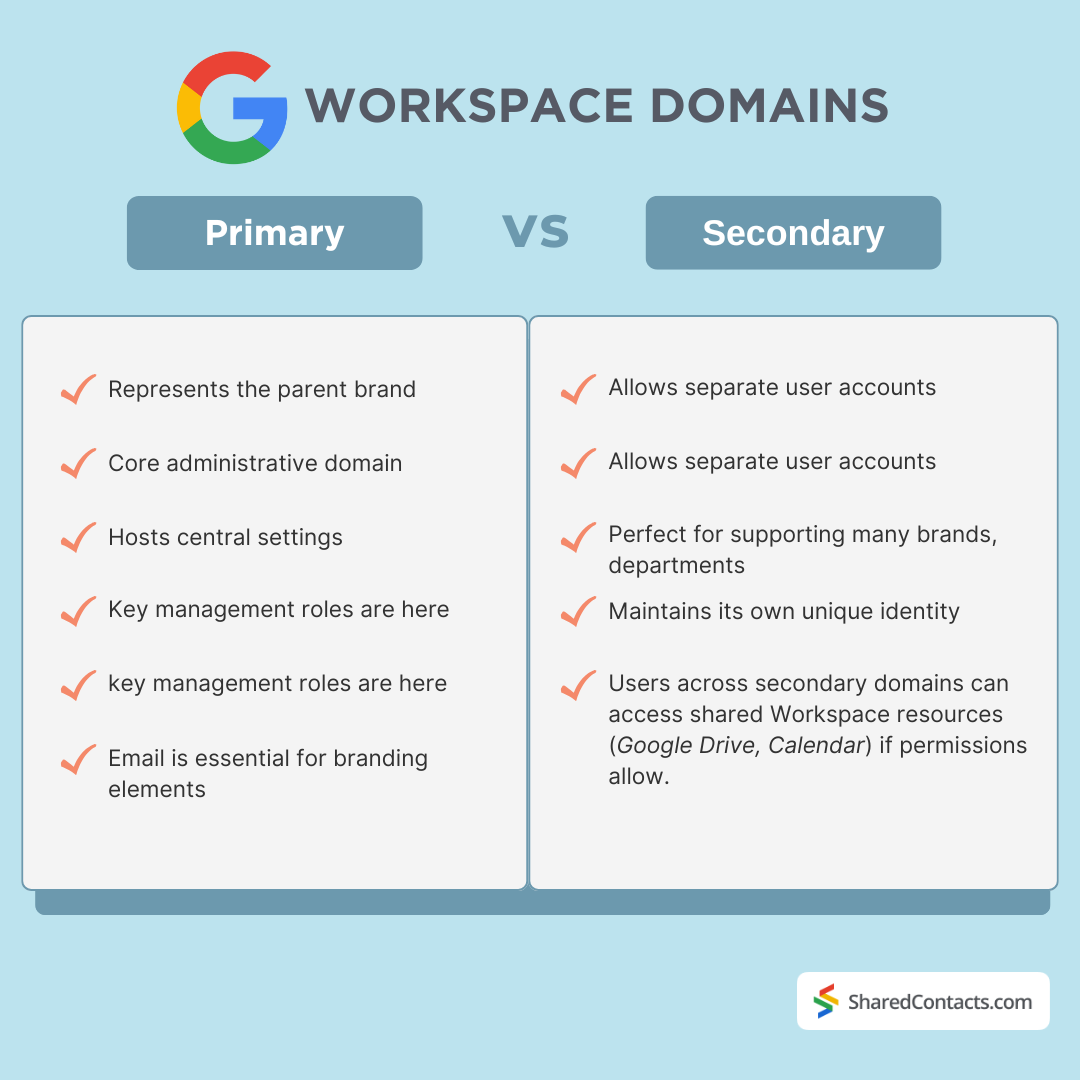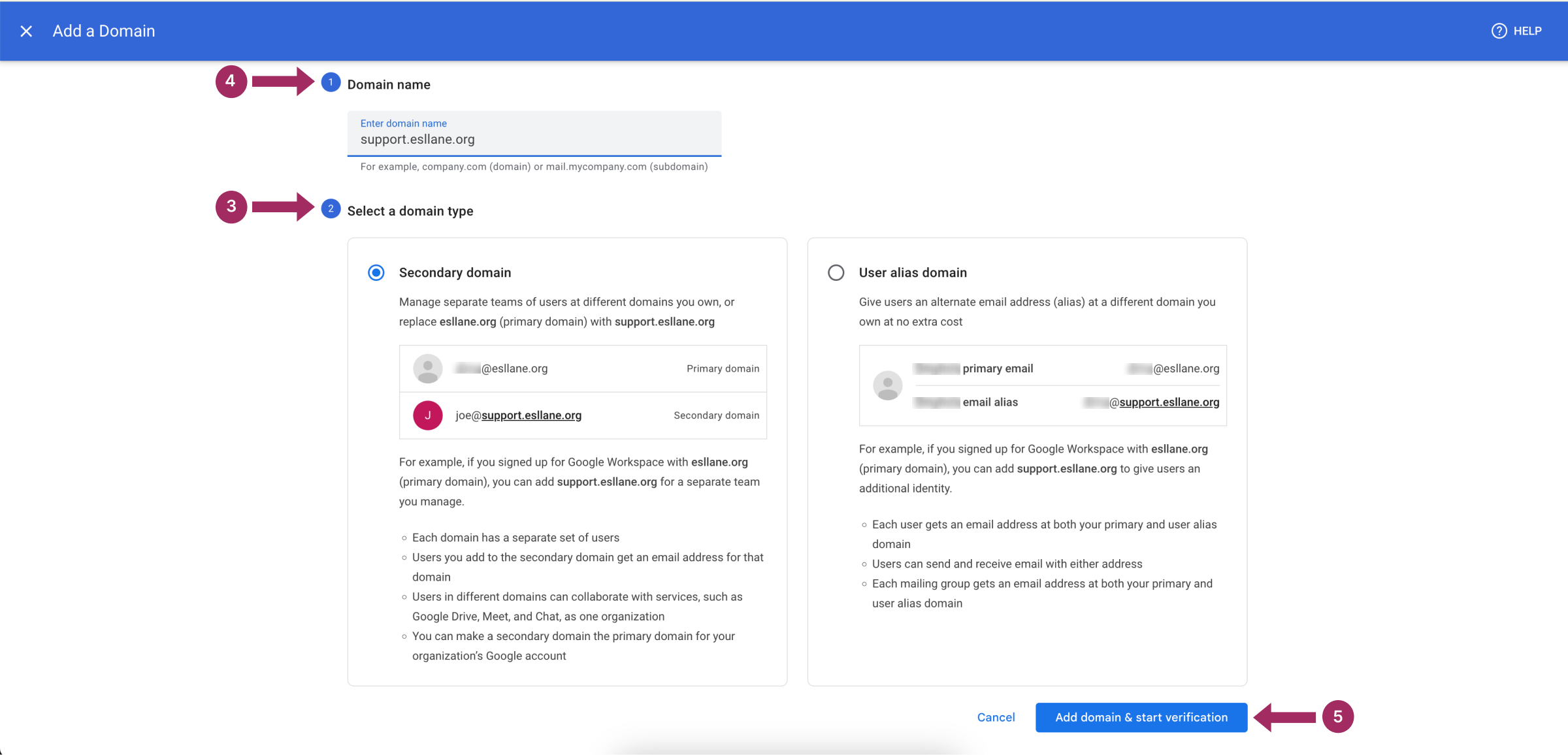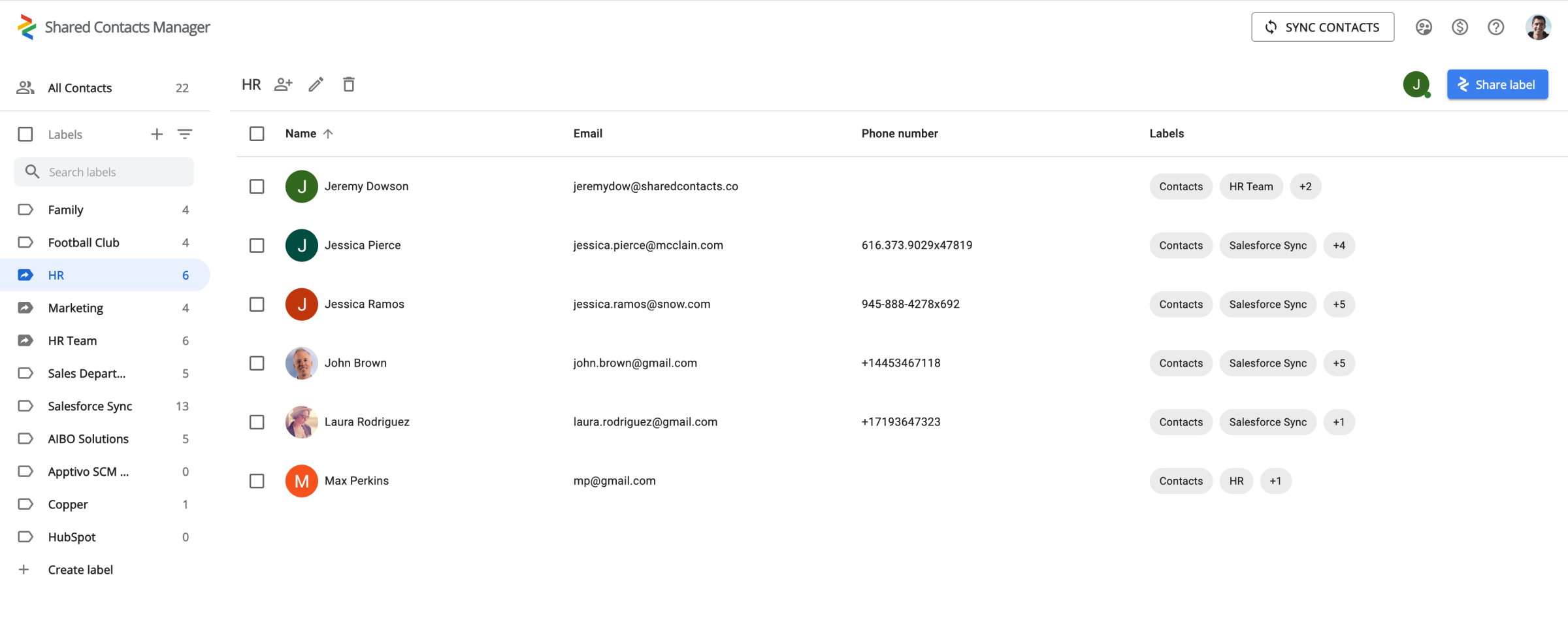Useiden verkkotunnusten käyttäminen Google Workspacessa

Useiden verkkotunnusten hallinta yhdellä Google Workspace -tilillä on usein välttämätöntä yrityksille, jotka toimivat eri tuotemerkkien, palvelujen tai maantieteellisten sijaintien välillä. Tämä ominaisuus tarjoaa yrityksille joustavuutta yhtenäistää toimintojaan, yksinkertaistaa hallintoa ja ylläpitää yhtenäistä brändiä useilla verkkotunnuksilla - ja pitää samalla hallinnan keskitettynä ja suoraviivaisena. Google Workspace -verkkotunnuksista puhuttaessa on tärkeää ymmärtää ensisijaisten, toissijaisten ja alias-verkkotunnusten välinen ero.
Käyttäjät voivat lisätä oman verkkotunnuksensa toissijaiseksi tai alias-verkkotunnukseksi eri yritysten tai tarkoitusten, kuten markkinointikampanjoiden tai tapahtumarekisteröintien, hallintaa varten ja samalla määritellä yksityiskohtaisesti näihin verkkotunnustyyppeihin liittyvät erityispiirteet ja rajoitukset. Google Workspacen usean verkkotunnuksen tuen ansiosta yritykset saavat tehokkaan työkalun sähköpostiosoitteiden, käyttäjätilien ja viestintäkanavien yhdistämiseen. Tämä asetus mahdollistaa tehokkaan organisoinnin ilman erillisten järjestelmien hallinnoimisesta aiheutuvaa vaivaa kunkin verkkotunnuksen osalta. Lisäksi yrityksille, joiden on jaettava yhteystietoja eri verkkotunnusten välillä, on tarjolla työkaluja, kuten Shared Contacts Manager tarjoavat olennaisia yhteyksien jakamisratkaisuja, joiden avulla eri tiimit voivat pitää yhteyttä toisiinsa.
Mikä on monialuetuki Google Workspacessa?
Google Workspacen usean verkkotunnuksen tuki antaa yrityksille mahdollisuuden hallita useita verkkotunnuksia yhdellä Workspace-tilillä. Sen sijaan, että yritykset loisivat erillisiä tilejä tai vaihtaisivat eri järjestelmien välillä, ne voivat yhdistää kaiken - sähköpostista käyttäjien käyttöoikeuksiin - yhteen keskitettyyn ympäristöön. Tämä on erittäin hyödyllistä organisaatioille, jotka ylläpitävät useita tuotemerkkejä, palveluita tai maantieteellisiä toimipisteitä saman sateenvarjon alla.
Usean verkkotunnuksen tuen avulla yritykset voivat ylläpitää sekä ensisijaista verkkotunnusta, yleensä pääbrändin verkkotunnusta, että lisätä yhden tai useamman toissijaisen verkkotunnuksen. Kullekin verkkotunnukselle voidaan määrittää yksilölliset sähköpostiosoitteet ja käyttäjätilit, jolloin työntekijöiden on helppo työskennellä eri tuotemerkkien tai osastojen alla ilman erillisiä Google Workspace -tilejä. Tämän joustavuuden ansiosta yritykset voivat tarjota kullekin tuotemerkille tai osastolle sopivia mukautettuja sähköpostiosoitteita, kuten esim. sales@brand1.com ja support@brand2.comkaikki yhden Workspace-tilin alla.
Yleiskatsaus ensisijaisiin ja toissijaisiin toimialueisiin
Google Workspacessa jokainen usean toimialueen asetus alkaa ensisijaisella toimialueella. Tämä on tyypillisesti organisaatioon liittyvä pääverkkotunnus, jota käytetään hallinnolliseen käyttöön. Sen jälkeen lisätään toissijaisia verkkotunnuksia, jotta toimintoja voidaan laajentaa muihin verkkotunnuksiin.
Ensisijainen toimialue
Tämä on organisaation tärkein verkkotunnus, ja se edustaa yleensä emobrändiä. Se toimii keskeisenä hallinnollisena verkkotunnuksena, ja siinä hallinnoidaan usein suurinta osaa hallinnollisista tileistä ja keskeisistä asetuksista. Ensisijaisen verkkotunnuksen sähköpostiosoite on elintärkeä, sillä tietyt olennaiset ominaisuudet ja tiedot, kuten organisaation nimi ja logo, liittyvät yksinomaan tähän ensisijaiseen verkkotunnukseen.
Toissijaiset verkkotunnukset
Nämä ovat organisaatioon kuuluvia lisäalueita. Toissijaisilla verkkotunnuksilla voi olla erilliset käyttäjätilit ja sähköpostit, jotka ovat yksilöllisiä kullekin verkkotunnukselle. Niitä hallitaan kuitenkin samalla Workspace-tilillä, mikä tarkoittaa, että ensisijaisen toimialueen ylläpitäjillä on täysi hallintaoikeus kaikkiin toissijaisiin toimialueisiin.

Ensisijaisten ja toissijaisten verkkotunnusten roolit auttavat yrityksiä pitämään toiminnot järjestyksessä, jolloin jokaisella tuotemerkillä tai sivuliikkeellä on oma identiteettinsä, mutta ne ovat osa kokonaisorganisaatiota.
Aliasien ja toissijaisten verkkotunnusten erot
Useiden verkkotunnusten perustamiseen liittyvät yritykset kysyvät usein, pitäisikö niiden käyttää verkkotunnusten aliaksia vai lisätä toinen verkkotunnus. Molemmat vaihtoehdot laajentavat Google Workspacen ominaisuuksia, mutta niillä on eri tarkoitus.
Verkkotunnukset
Verkkotunnusalias on ylimääräinen verkkotunnus, joka ohjataan ensisijaiseen verkkotunnukseen. Esimerkiksi osoitteella info@brand1.com voi olla alias-osoite info@brand2.com, jolloin kumpaankin osoitteeseen lähetetyt sähköpostit päätyvät samaan postilaatikkoon. Verkkotunnuksen aliakset toimivat hyvin, kun haluat, että useat sähköpostiosoitteet osoittavat samaan käyttäjään ilman erillisten tilien hallintaa.
Alias-osoitteen viestit saapuvat automaattisesti käyttäjän postilaatikkoon. Voit testata tämän lähettämällä viestin eri tililtä alias-osoitteeseen ja tarkistamalla, saapuuko se perille. Jos näin ei tapahdu, tarkista vianmääritys tarkistamalla verkkotunnuksen asetukset.
Toissijaiset verkkotunnukset
Toisin kuin aliakset, toissijaiset toimialueet toimivat itsenäisesti Workspace-ympäristössä. Jokaisella toissijaisella toimialueella on omat käyttäjänsä, sähköpostiosoitteensa ja tilinsä. Tämä asetus sopii erinomaisesti yrityksille, jotka haluavat erillisen brändin ja käyttäjien hallinnan jokaiselle verkkotunnukselle, mutta samalla ylläpitävät keskitettyä hallinnointia.
Valinta verkkotunnusten ja toissijaisten verkkotunnusten välillä riippuu organisaatiosi tarpeista. Jos hallinnoit useita eri identiteettejä omaavia tuotemerkkejä, toissijaisen verkkotunnuksen lisääminen on järkevää. Samaan aikaan verkkotunnukset ovat tehokkaita yksinkertaisemmissa asetuksissa, joissa tarvitaan vain vaihtoehtoisia sähköpostiosoitteita saman tuotemerkin sisällä.
Google Workspacen monialuetuki antaa organisaatioille mahdollisuuden jäsentää sähköpostin, brändin ja käyttäjien käyttöoikeudet joustavasti omien tarpeidensa mukaan, kaikki yhden tehokkaan järjestelmän alla. Tämä auttaa kaikenkokoisia yrityksiä toimimaan lukuisilla verkkotunnuksilla ilman erillisten tilien hallinnoinnin monimutkaisuutta.
Useiden verkkotunnusten määrittäminen Google Workspacessa
Useiden verkkotunnusten määrittäminen Google Workspacessa on yleensä yksinkertainen prosessi, mutta on kuitenkin muutama erityinen asia, jotka sinun on hyvä tietää. Tässä on vaiheittainen opas, jonka avulla pääset alkuun uusien verkkotunnusten lisäämisestä asetusten määrittämiseen usean verkkotunnuksen hallintaa varten.
Voit lisätä oman verkkotunnuksen toissijaiseksi tai alias-verkkotunnukseksi, jolla voit hallita eri yrityksiä tai tarkoituksia, kuten markkinointikampanjoita tai tapahtumien rekisteröintejä, Google Workspace- tai Cloud Identity -tililläsi.
Toisen verkkotunnuksen lisääminen Google Workspace -tilille
Toissijaisen verkkotunnuksen lisääminen tarkoittaa, että perustat erilliset sähköpostit ja käyttäjät kummallekin verkkotunnukselle samaan Google Workspace -ympäristöön. Cloud Identity -tilin avulla voit lisätä toissijaisia verkkotunnuksia tai alias-verkkotunnuksia, mikä tarjoaa organisatorisia etuja ja erityisiä toimintoja useiden yritysten tai tuotemerkkien hallintaan tämän palvelun kautta. Seuraa näitä ohjeita lisätäksesi toissijaisen verkkotunnuksen tilillesi:
- Kirjaudu sisään Google Admin Console käyttämällä tiliä, jolla on järjestelmänvalvojan oikeudet.
- Valitse hallintakonsolin kojelaudassa Domains-valikko ja valitse sitten Lisää verkkotunnus.

- Valitse vaihtoehto lisätä Toissijainen verkkotunnus tai Käyttäjän alias verkkotunnusriippuen siitä, haluatko perustaa täysin erillisen verkkotunnuksen vai peitenimen, joka osoittaa ensisijaiseen verkkotunnukseen.
- Kirjoita nimi, jonka haluat lisätä toissijaiseksi verkkotunnukseksi.
- Klikkaa Lisää verkkotunnus ja aloita todentaminen. Seuraa ohjeita, joihin yleensä kuuluu TXT-varmennustietueen lisääminen verkkotunnuksesi DNS-asetuksiin.

Kun vahvistus on valmis, Google Workspace vahvistaa uuden verkkotunnuksen lisäämisen, ja voit hallita käyttäjiä, sähköpostiosoitteita ja muita asetuksia Workspace-päätililläsi.
Sähköpostiasetusten määrittäminen useita verkkotunnuksia varten
Sähköpostiasetusten oikea määrittäminen takaa sujuvan viestinnän kullakin verkkotunnuksella. Näin määrität sähköpostin Google Workspacessa:
- Luo yksilöllisiä sähköpostiosoitteita. Voit määrittää kullekin uudelle käyttäjälle sähköpostiosoitteet käyttämällä ensisijaista tai toissijaista verkkotunnusta. Esimerkiksi työntekijällä voi olla name@mybrand1.com ja name@mybrand2.com heidän profiiliinsa liittyvät sähköpostit.
- Määritä sähköpostin reititys. Jos haluat pitää sähköpostin reitityksen yksinkertaisena, määritä reitityssäännöt ohjaamaan viestit oikeisiin postilaatikoihin toimialueen perusteella. Tämä on hyödyllistä, jos haluat, että tietyt yhdelle verkkotunnukselle lähetetyt sähköpostiviestit ohjataan toiseen verkkotunnukseen tai jos käytät peitenimiä.
- Määritä verkkotunnuskohtaiset sähköpostisignaatiot. Jos haluat pitää brändin yhtenäisenä, käytä mukautettuja sähköpostisignaaleja. Näin käyttäjillä voi olla erilliset allekirjoitukset ja yhteystiedot kullekin edustamalleen tuotemerkille.
- Testaa sähköpostin toimivuutta. Lähetä testisähköposteja verkkotunnusten välillä ja ulkoisesti tarkistaaksesi, että kaikki sähköpostin reititys-, vastaanotto- ja allekirjoitusasetukset toimivat odotetulla tavalla.
Ensisijaisen verkkotunnuksen sähköpostiosoite on ratkaisevan tärkeä, sillä se yhdistää olennaiset ominaisuudet ja tiedot, kuten organisaation nimen ja logon, yksinomaan ensisijaiseen verkkotunnukseen. Käyttäjät voivat lähettää ja vastaanottaa sähköposteja sekä ensisijaisesta että toissijaisesta verkkotunnuksesta, mutta kirjautuminen ja tiedostojen luominen on rajoitettu ensisijaiseen sähköpostiosoitteeseen.
Uusien käyttäjätilien lisääminen ensisijaisiin tai toissijaisiin verkkotunnuksiin
Google Workspacen useiden verkkotunnusten avulla voit määrittää käyttäjille tiettyjä verkkotunnuksia tai antaa heille pääsyn useisiin verkkotunnuksiin tarpeen mukaan. Näin toimitaan:
Vaihe 1: Lisää uusia käyttäjiä asianmukaiseen toimialueeseen.. Kun luot uutta käyttäjää, valitse, minkä verkkotunnuksen haluat määrittää hänen tililleen valitsemalla kaikkien käytettävissä olevien verkkotunnusten luettelosta. Tällä tavoin heidän sähköpostiosoitteensa vastaa oikeaa verkkotunnusta. Voit myös lisätä käyttäjiä suoraan Hallitse verkkotunnuksia ikkunassa klikkaamalla Lisää käyttäjiä nappi. 
Täytä seuraavassa ikkunassa uuden käyttäjän tiedot, kuten nimi, ensisijainen sähköpostiosoite ja verkkotunnus, johon käyttäjän on kuuluttava. Napsauta . Lisää uusi käyttäjä jatkaa. 
On tärkeää joko tulostaa tai kopioida tämän käyttäjän kirjautumistiedot jonnekin myöhempää käyttöä varten. Vaihtoehtoisesti voit lähettää kirjautumisohjeet käyttäjälle. Klikkaa Valmis prosessin loppuun saattamiseksi.
Vaihe 2: Salli monialueen käyttö tietyille käyttäjille. Työntekijöille, jotka tarvitsevat pääsyn sähköposteihin tai resursseihin useilla verkkotunnuksilla, voit luoda useita sähköpostiosoitteita kunkin verkkotunnuksen alle tai määrittää aliaksia. Tämä voi olla hyödyllistä työntekijöille, jotka ovat mukana tuotemerkin rajat ylittävissä toiminnoissa, kuten johdossa tai IT:ssä.
Vaihe 3: Käyttäjien järjestäminen toimialuekohtaisiin ryhmiin. Voit yhdenmukaistaa viestintää luomalla käyttäjäryhmiä kullekin toimialueelle (esim, marketing@mybrand1.com tai support@mybrand2.com). Tämä auttaa osastoja pysymään järjestyksessä tuotemerkeittäin, mikä mahdollistaa tehokkaan ryhmäsähköpostin ja viestinnän Workspacessa.
Useiden verkkotunnusten käytön edut Google Workspacessa
Useiden verkkotunnusten käyttäminen Google Workspacessa tarjoaa lukuisia etuja yrityksille, erityisesti niille, joilla on useita tuotemerkkejä, osastoja tai maantieteellisiä sijainteja. Se yksinkertaistaa hallintoa, parantaa brändinhallintaa ja tukee yhtenäistä käyttäjäkokemusta organisaation eri osissa. Cloud Identity -tilin avulla käyttäjät voivat lisätä toissijaisia tai alias-verkkotunnuksia, mikä tarjoaa merkittäviä organisatorisia etuja ja erityistoimintoja useiden yritysten tai tuotemerkkien hallintaan tämän palvelun kautta. Seuraavassa on joitakin keskeisiä etuja:
Parannettu brändinhallinta ja ammattimaisuus
Yksi Google Workspacen usean verkkotunnuksen tuen suurimmista eduista on mahdollisuus ylläpitää erillisiä identiteettejä kullekin tuotemerkille tai osastolle samalla, kun kaikkea hallitaan yhdellä tilillä. Tämän rakenteen ansiosta organisaatiot voivat määrittää yksilöllisiä sähköposteja ja verkkotunnuksia, jotka heijastavat kunkin brändin identiteettiä, mikä lisää ammattimaisuutta ja brändin yhdenmukaistamista. Lisäksi käyttäjien alias-verkkotunnukset mahdollistavat useiden sähköpostiosoitteiden käytön ilman käyttäjäkohtaisia lisäkustannuksia. Tämä voi olla erinomainen ratkaisu yksittäisille henkilöille tai pienille tiimeille, jotka hoitavat erilaisia sivuprojekteja tai tuotemerkkejä.
Esimerkiksi yritys, jolla on kaksi tuotemerkkiä - vaikkapa, mybranda.com ja mybrandb.com-voi perustaa support@mybranda.com ja support@mybrandb.com erillisinä sähköpostiosoitteina kullekin tiimille, jotta asiakkaat tunnistavat nopeasti oikean brändin viestinnän ja luottavat siihen. Tämä räätälöinnin taso auttaa yrityksiä luomaan ammattimaisen kuvan ja varmistamaan, että kaikki viestintä vastaa kunkin brändin sävyä ja ääntä.
Yksinkertaistettu IT-hallinta useille toimipisteille tai palveluille
Monimutkaisen rakenteen omaaville organisaatioille - esimerkiksi organisaatioille, joissa on useita toimistoja, palveluosastoja tai maantieteellisiä sijainteja - Google Workspacen monialuetuki tarjoaa keskitetyn tavan hallita IT-tarpeita kautta linjan. Yhden Google Workspace -tilin avulla ylläpitäjät voivat valvoa kunkin toimialueen käyttäjäoikeuksia, käyttöoikeuksien valvontaa ja tiliasetuksia, mikä säästää aikaa ja resursseja.
Jos tiimin jäsenet kohtaavat ongelmia alias-osoitteeseensa välitettyjen viestien vastaanottamisessa, heidän on otettava yhteyttä verkkotunnuksen isäntään. Verkkotunnuksen isäntä voi auttaa tarkistamaan, että verkkotunnuksen varmennus ja MX-tietueet on asetettu oikein, mikä on tärkeää sähköpostin toimivuuden kannalta.
Tämä keskitetty lähestymistapa tietotekniikan hallintaan on erittäin hyödyllinen globaaleille yrityksille, sillä se auttaa niitä asettamaan käytäntöjä, valvomaan toimintaa ja hallitsemaan tietoturvaprotokollia johdonmukaisesti kaikilla toimialueilla. Lisäksi usean verkkotunnuksen tuki poistaa tarpeen hallita erillisiä tilejä tai alustoja kullekin tuotemerkille. Se helpottaa IT-tiimien hallinnointia ja vähentää virheriskiä.
Joustavuus liiketoiminnan kasvua ja laajentumista varten
Google Workspacen monialuetoiminto on myös loistava ratkaisu yrityksille, jotka ennakoivat kasvua tai uusia yritysostoja. Koska Google Workspace mahdollistaa uusien verkkotunnusten lisäämisen niin helposti, se tarjoaa organisaatioille joustavuutta integroida nopeasti uusia tuotemerkkejä, osastoja tai markkinoita olemassa olevaan järjestelmään.
Toissijaiset verkkotunnukset tai alias-verkkotunnukset voivat auttaa yrityksiä siirtymään sujuvasti uudelleenbrändäyspyrkimysten tai uusien yrityskauppojen aikana, sillä ne luovat ainutlaatuisia identiteettejä eri markkinointialoitteita varten ilman, että useiden tilien hallinnointi on monimutkaista.
Jos yritys esimerkiksi hankkii uuden yrityksen tai lanseeraa uuden tuotemerkin, uuden verkkotunnuksen lisääminen toissijaiseksi verkkotunnukseksi on yksinkertaista, ja sen avulla samat resurssit ja työkalut ovat välittömästi käytettävissä. Tämä mukautuvuus auttaa yrityksiä sopeutumaan ja laajentumaan investoimatta erilliseen sähköposti- tai tuottavuusjärjestelmään jokaista uutta yritystä varten.
Parempi viestintä ja yhteistyö eri tuotemerkkien välillä
Useiden verkkotunnusten käyttäminen Google Workspacessa ei pelkästään tehosta brändinhallintaa. Se edistää myös sisäistä yhteistyötä. Monen verkkotunnuksen tuen ansiosta eri tuotemerkkien alla työskentelevät työntekijät voivat silti käyttää yhteisiä Google Workspace -resursseja, kuten Google Drivea, kalenteria ja Meetiä, mikä mahdollistaa sujuvan ja yhtenäisen tiimityön.
Jokaisesta ylimääräisestä käyttäjätilistä aiheutuu kustannuksia, kun se liittyy toissijaisiin verkkotunnuksiin, kun taas käyttäjän alias-verkkotunnukset eivät aiheuta lisämaksuja, mikä tekee siitä taloudellisemman vaihtoehdon pienemmille tiimeille tai yksinyrittäjille, jotka hallinnoivat useita tuotemerkkejä.
Olivatpa työntekijät sitten mukana tuotemerkkien välisissä projekteissa tai heidän on kommunikoitava säännöllisesti eri osastojen välillä, tämä muoto mahdollistaa tiimien tehokkaan yhteistyön ilman esteitä. Yhdistämällä resurssit ja viestintävälineet yhden tilin alle yritykset voivat edistää yhteistoiminnallista työympäristöä, vaikka tiimit olisivat jakautuneet tuotemerkin tai sijainnin mukaan.
Tehokas yhteyksien jakaminen ja hallinta eri toimialueilla
Toinen erittäin arvokas hyöty monialuetuesta on mahdollisuus keskittää ja jakaa yhteystietoja tehokkaasti eri toimialueilla. Google Workspacen Shared Contacts Manager:n käyttäminen sovelluksen ja vastaavien työkalujen avulla tiimit voivat jakaa tärkeitä yhteystietoja toimialueiden välillä, mikä mahdollistaa paremman tiimien välisen viestinnän ja paljon sujuvammat työnkulut.

Yhteisen yhteystietojärjestelmän avulla eri alojen tiimin jäsenet voivat käyttää asiakastietoja, myyjien tietoja ja yhteistyökumppaneiden yhteystietoja yhdessä paikassa. Se säästää aikaa ja ehkäisee väärinkäytöksiä, sillä kaikki saavat tarvitsemansa yhteystiedot käyttöönsä riippumatta siitä, mihin toimialueeseen he kuuluvat.
Google Workspacen monialuetuki järkeistää tuotemerkkien hallintaa, edistää yhteistyötä ja tukee joustavaa kasvua, mikä tekee siitä tehokkaan työkalun kaikenkokoisille organisaatioille. Paremman brändäyksen, keskitetyn hallinnan ja tehokkaan yhteystietojen jakamisen ansiosta monialuetoiminnallisuuden avulla yritykset voivat maksimoida Google Workspace -asetuksensa ja tarjota samalla järjestäytyneen, ammattimaisen käyttäjäkokemuksen kaikkialla.
Päätelmä
Useiden verkkotunnusten hallinta Google Workspacessa on tehokas lähestymistapa organisaatioille, joilla on erilaisia tuotemerkkejä, toimipisteitä tai liiketoimintayksiköitä. Yhdistämällä kaiken sähköpostiosoitteista käyttäjäoikeuksiin yhden järjestelmän alle yritykset voivat yksinkertaistaa toimintaansa, säilyttää yhtenäisen brändin ja helpottaa eri tiimien välistä yhteistyötä. Google Workspacen monialuetuki tarjoaa joustavuutta, jota yritysten omistajien ei pitäisi aliarvioida.
Pelkän verkkotunnusten määrittämisen lisäksi Shared Contacts Manager:n kaltaisten työkalujen hyödyntäminen parantaa yhteyksien jakamista ja viestintää eri verkkotunnusten välillä, ja parhaiden käytäntöjen noudattaminen - kuten johdonmukaisen brändin ylläpitäminen, käyttäjien järjestäminen verkkotunnusten mukaan ja asetusten säännöllinen auditointi - auttaa organisaatiotasi maksimoimaan usean verkkotunnuksen toiminnallisuuden edut.
Kaikille yrityksille Google Workspacen monialuekäyttöominaisuudet tarjoavat tehokkaan ja toimivan ratkaisun, joka tukee kasvua ja lisää tuottavuutta.




Ei kommentteja